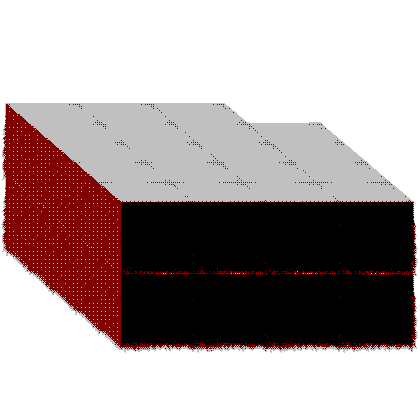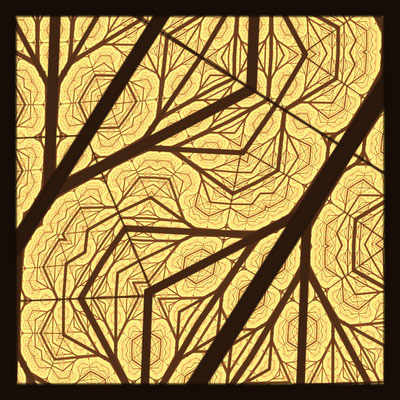
rmx of gif by unknown artist
There they go again. The New York Times is turning the late Steven Parrino into a misunderstood Van Gogh figure. Per writer Dorothy Spears:
For years, when the artist Steven Parrino wasn’t jamming power chords on his electric guitar or tinkering with his motorcycle in his garagelike studio in Brooklyn, he was recycling his unsold paintings: twisting them into eccentric new shapes, smashing their stretcher bars or stabbing them repeatedly with scissors.
His destructive approach to art making earned him the admiration of some fellow artists, but it also concealed a painful reality: There was no market for his work. In eight years and five solo New York shows, his former dealer José Freire [of Team Gallery] said, he sold only two of Mr. Parrino’s paintings, one for $9,000 and the other for $10,000.
Parrino is now a hot, posthumous Gagosian artist, we're given to understand. Based on one quote from a dealer who no longer represents the Parrino estate, the Times--"your place for one source shopping"--claims Parrino had no market. But what about all the other solo shows on his vitae, most of them in Europe (at least 25 non-Team exhibitions)? Spears recounts a secondhand story of a Swiss dealer complaining he couldn't sell Parrino's work, but the source of this tale isn't clear. Spears quotes a fax Parrino ostensibly sent a Swiss curator "instructing him to remove all of Parrino's work" from the dealer's gallery but there is no quote indicating she talked to the dealer himself. The dealer's gallery is not named.
Spears' tale of woe prompted the anaba blog to ask how Parrino made ends meet, to which query an anonymous commenter eagerly chimed in that Parrino was "supported by his wife for a good amount of the time" Parrino was showing at Team.
The BS is clearly flying.
A different picture of the Parrino balance sheet is suggested by people who knew him, posting on artist Bill Schwarz's blog. According to these commenters, Parrino had a career and a reputation in Europe and sold work there, and the "only sold two paintings in his lifetime" legend the Times attempts to foster is misleading. As for the "wife support" claim, during an approximately 21-year working career Parrino was married for 6-8 years. According to Lisa Ruyter, artist and co-founder of Team, chiming in on the Schwarz thread, Parrino was not married while at the gallery. One commenter who knew Parrino later in life doubts he was selling much, saying the artist was "hot" in the '80s and "not" from the '90s onward.
An artist's means of support is generally not relevant to anything and this blog wouldn't talk about it. Unfortunately the "newspaper of record" has made it relevant by suggesting a relationship between Parrino's content (recycling, destroying artworks) and his economic status vis a vis the art world. This doesn't square with what I know of Parrino's aesthetic. Sometimes nihilism does mean nihilism, prompting the people it makes uncomfortable to explain it away as career frustration.
Related: An earlier post on how the Times' Parrino obit subtly added to the artist's legend (while not deigning to praise his work). And more corrections of the Times Parrino obit: Parrino did not consider himself a "Neo Geo" artist.
Update: More from anaba.
Update 2: This post has been revised to include the Times quote and a few afterthoughts.
Update 3: And continues to be revised, WIKI style, as new facts and opinions come in.
Update 4: For the Lisa Ruyter referred to in this post see Francis Ruyter.
AB NewsWire, July 23:
HasBeen Games, a closely-held corporation owned by the Eli Sneed family for several generations, has recently taken an aggressive copyright stance to protect its interest in several popular games, including Go Fish, "Indian" style poker, and Duck Duck Goose.
"When I saw a knockoff of Go Fish on Facebook, steam came out my ears," says Beavis Sneed, the current CEO and great-grandson of founder Eli.
In addition to suing Facebook, HasBeen is also dispatching private detectives to summer camps around the US, in hopes of stanching unauthorized playing of Go Fish, a game developed and copyrighted by Eli Sneed.
"If one of our operatives hears your child say 'Give me all your fours,' Mom and Dad, you will be receiving a letter from an attorney by the time Junior gets home," a statement from Beavis Sneed's office says.
"This is no fishing expedition, but you will be netted," stated the statement.

...in a good way. From desaxismundi. Giant version.
From Paddy Johnson's notes on the Net Aesthetics 2.0 panel at the New Museum:
Group surf clubs are discussed at length – communication about what’s art and what’s not on these sites isn’t deemed to be an issue for the artists though Tom Moody admits the issue is confusing. Surf clubs demonstrate that artists use their “art head” when surfing. Moody asks, How do you stand out? Do I care? Do I stop people from putting it into contexts I didn’t intend?
Something I posted two days before the panel:
Some 20th Century writers complained that reality (in a hypercharged mediated environment) was outstripping their ability to spin fiction.
Artists, too, have to compete with real world content far more captivating than anything they could come up with, which the Internet effectively gathers all in one place (sneezing Pandas, etc). Two possible responses are (1) to continually rise above it through aesthetic and conceptual framing and posturing or (2) to disappear into it and trust the viewer to ultimately sort out what's going on. The Web is a consumer's medium, not a producer's, so the artist is inexorably led to consumption as a "practice." The degree of criticality can only be inferred, not implied.
At the end of the panel Q&A, an art dealer who specializes in computer-based and new media art, who was sitting in the audience, made this comment to the "surf club" artists who had been showing our work for the preceding hour or so:
"I haven't seen anything new here--it's just things we already know like the 'the found object' and 'the collage.'"
So much for inferred criticality. We are off to a bad start here.